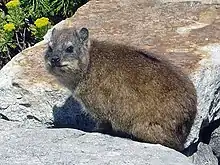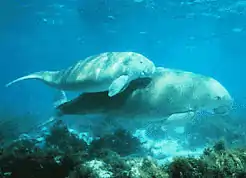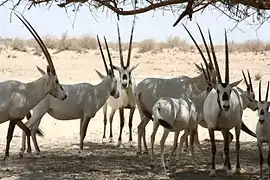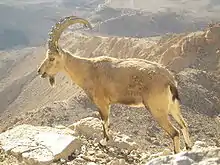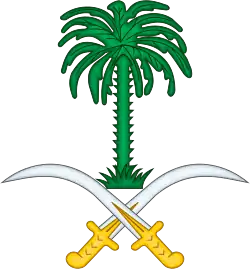List of mammals of Saudi Arabia
This is a list of the mammal species present in Saudi Arabia. There are 78 mammal species in Saudi Arabia, of which three are critically endangered, three are endangered, nine are vulnerable, and two are near threatened.
The following tags are used to highlight each species' conservation status as assessed by the International Union for Conservation of Nature:
| EX | Extinct | No reasonable doubt that the last individual has died. |
| EW | Extinct in the wild | Known only to survive in captivity or as a naturalized populations well outside its previous range. |
| CR | Critically endangered | The species is in imminent risk of extinction in the wild. |
| EN | Endangered | The species is facing an extremely high risk of extinction in the wild. |
| VU | Vulnerable | The species is facing a high risk of extinction in the wild. |
| NT | Near threatened | The species does not meet any of the criteria that would categorise it as risking extinction but it is likely to do so in the future. |
| LC | Least concern | There are no current identifiable risks to the species. |
| DD | Data deficient | There is inadequate information to make an assessment of the risks to this species. |
Order: Hyracoidea (hyraxes)
The hyraxes are any of four species of fairly small, thickset, herbivorous mammals in the order Hyracoidea. About the size of a domestic cat they are well-furred, with rounded bodies and a stumpy tail. They are native to Africa and the Middle East.
- Family: Procaviidae (hyraxes)
- Genus: Procavia
- Cape hyrax, P. capensis LC
- Genus: Procavia
Order: Sirenia (manatees and dugongs)
Sirenia is an order of fully aquatic, herbivorous mammals that inhabit rivers, estuaries, coastal marine waters, swamps, and marine wetlands. All four species are endangered.
- Family: Dugongidae
Order: Primates
The order Primates contains humans and their closest relatives: lemurs, lorisoids, monkeys, and apes.
- Suborder: Haplorhini
- Infraorder: Simiiformes
- Parvorder: Catarrhini
- Superfamily: Cercopithecoidea
- Family: Cercopithecidae (Old World monkeys)
- Genus: Papio
- Hamadryas baboon, P. hamadryas LC
- Genus: Papio
- Family: Cercopithecidae (Old World monkeys)
- Superfamily: Cercopithecoidea
- Parvorder: Catarrhini
- Infraorder: Simiiformes
Order: Rodentia (rodents)
Rodents make up the largest order of mammals, with over 40% of mammalian species. They have two incisors in the upper and lower jaw which grow continually and must be kept short by gnawing. Most rodents are small though the capybara can weigh up to 45 kg (99 lb).
- Suborder: Hystricognathi
- Family: Hystricidae (Old World porcupines)
- Genus: Hystrix
- Indian porcupine, Hystrix indica LC
- Genus: Hystrix
- Family: Hystricidae (Old World porcupines)
- Suborder: Sciurognathi
- Family: Gliridae (dormice)
- Subfamily: Leithiinae
- Genus: Eliomys
- Asian garden dormouse, Eliomys melanurus LC
- Genus: Eliomys
- Subfamily: Leithiinae
- Family: Dipodidae (jerboas)
- Subfamily: Allactaginae
- Genus: Allactaga
- Euphrates jerboa, Allactaga euphratica LC
- Genus: Allactaga
- Subfamily: Dipodinae
- Genus: Jaculus
- Lesser Egyptian jerboa, Jaculus jaculus LC
- Greater Egyptian jerboa, Jaculus orientalis LC
- Genus: Jaculus
- Subfamily: Allactaginae
- Family: Muridae (mice, rats, voles, gerbils, hamsters, etc.)
- Subfamily: Deomyinae
- Genus: Acomys
- Cairo spiny mouse, Acomys cahirinus LC
- Golden spiny mouse, Acomys russatus LC
- Genus: Acomys
- Subfamily: Gerbillinae
- Genus: Gerbillus
- Cheesman's gerbil, Gerbillus cheesmani LC
- Wagner's gerbil, Gerbillus dasyurus LC
- Pygmy gerbil, Gerbillus henleyi LC
- Balochistan gerbil, Gerbillus nanus LC
- Large Aden gerbil, Gerbillus poecilops LC
- Genus: Meriones
- Arabian jird, Meriones arimalius EN
- Sundevall's jird, Meriones crassus LC
- Libyan jird, Meriones libycus LC
- King jird, Meriones rex LC
- Genus: Psammomys
- Sand rat, Psammomys obesus LC
- Genus: Sekeetamys
- Bushy-tailed jird, Sekeetamys calurus LC
- Genus: Gerbillus
- Subfamily: Murinae
- Genus: Apodemus
- Broad-toothed field mouse, Apodemus mystacinus LC
- Genus: Arvicanthis
- African grass rat, Arvicanthis niloticus LC
- Genus: Myomyscus
- Yemeni mouse, Myomys yemeni LC
- Genus: Nesokia
- Short-tailed bandicoot rat, Nesokia indica LC
- Genus: Apodemus
- Subfamily: Deomyinae
- Family: Gliridae (dormice)
Order: Erinaceomorpha (hedgehogs and gymnures)
The order Erinaceomorpha contains a single family, Erinaceidae, which comprise the hedgehogs and gymnures. The hedgehogs are easily recognised by their spines, while gymnures look more like large rats.
- Family: Erinaceidae (hedgehogs)
- Subfamily: Erinaceinae
- Genus: Paraechinus
- Desert hedgehog, P. aethiopicus LC
- Genus: Paraechinus
- Subfamily: Erinaceinae
Order: Chiroptera (bats)
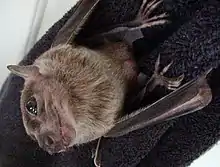
The bats' most distinguishing feature is that their forelimbs are developed as wings, making them the only mammals capable of flight. Bat species account for about 20% of all mammals.
- Family: Pteropodidae (flying foxes, Old World fruit bats)
- Subfamily: Pteropodinae
- Genus: Eidolon
- Straw-coloured fruit bat, Eidolon helvum LC
- Genus: Rousettus
- Egyptian fruit bat, Rousettus aegyptiacus LC
- Genus: Eidolon
- Subfamily: Pteropodinae
- Family: Vespertilionidae
- Subfamily: Myotinae
- Genus: Myotis
- Geoffroy's bat, M. emarginatus LC[1]
- Genus: Myotis
- Subfamily: Vespertilioninae
- Genus: Eptesicus
- Botta's serotine, Eptesicus bottae LC
- Genus: Hypsugo
- Bodenheimer's pipistrelle, Hypsugo bodenheimeri LC
- Genus: Nycticeinops
- Schlieffen's twilight bat, Nycticeinops schlieffeni LC
- Genus: Otonycteris
- Desert long-eared bat, Otonycteris hemprichii LC
- Genus: Pipistrellus
- Kuhl's pipistrelle, Pipistrellus kuhlii LC
- Genus: Plecotus
- Grey long-eared bat, Plecotus austriacus LC
- Genus: Rhyneptesicus
- Genus: Eptesicus
- Subfamily: Miniopterinae
- Genus: Miniopterus
- Common bent-wing bat, M. schreibersii VU[3]
- Genus: Miniopterus
- Subfamily: Myotinae
- Family: Rhinopomatidae
- Genus: Rhinopoma
- Lesser mouse-tailed bat, Rhinopoma hardwickei LC
- Greater mouse-tailed bat, Rhinopoma microphyllum LC
- Genus: Rhinopoma
- Family: Molossidae
- Genus: Chaerephon
- Nigerian free-tailed bat, Chaerephon nigeriae LC
- Genus: Mops
- Midas free-tailed bat, Mops midas LC
- Genus: Tadarida
- Egyptian free-tailed bat, Tadarida aegyptiaca LC
- European free-tailed bat, Tadarida teniotis LC
- Genus: Chaerephon
- Family: Emballonuridae
- Genus: Taphozous
- Egyptian tomb bat, Taphozous perforatus LC
- Genus: Taphozous
- Family: Nycteridae
- Genus: Nycteris
- Egyptian slit-faced bat, Nycteris thebaica LC
- Genus: Nycteris
- Family: Rhinolophidae
- Subfamily: Rhinolophinae
- Genus: Rhinolophus
- Geoffroy's horseshoe bat, Rhinolophus clivosus LC
- Greater horseshoe bat, R. ferrumequinum LC[4]
- Lesser horseshoe bat, R. hipposideros LC[5]
- Genus: Rhinolophus
- Subfamily: Hipposiderinae
- Genus: Asellia
- Patrizi's trident leaf-nosed bat, Asellia patrizii VU
- Trident leaf-nosed bat, Asellia tridens LC
- Genus: Hipposideros
- Ethiopian large-eared roundleaf bat, Hipposideros megalotis NT
- Genus: Asellia
- Subfamily: Rhinolophinae
Order: Cetacea (whales)
The order Cetacea includes whales, dolphins and porpoises. They are the mammals most fully adapted to aquatic life with a spindle-shaped nearly hairless body, protected by a thick layer of blubber, and forelimbs and tail modified to provide propulsion underwater.
- Suborder: Mysticeti
- Family: Balaenopteridae
- Subfamily: Balaenopterinae
- Genus: Balaenoptera
- Fin whale, Balaenoptera physalus EN[6]
- Sei whale, Balaenoptera borealis EN[6]
- Bryde's whale, Balaenoptera edeni DD
- Minke whale, Balaenoptera acutorostrata nt[7]
- Genus: Balaenoptera
- Subfamily: Megapterinae
- Genus: Megaptera
- Humpback whale, Megaptera novaeangliae CR (Arabian Sea population)[8]
- Genus: Megaptera
- Subfamily: Balaenopterinae
- Family: Balaenopteridae
- Suborder: Odontoceti
- Superfamily: Platanistoidea
- Family: Phocoenidae
- Genus: Neophocaena
- Finless porpoise, Neophocaena phocaenoides DD
- Genus: Neophocaena
- Family: Kogiidae
- Genus: Kogia
- Dwarf sperm whale, Kogia sima LR/lc[6]
- Genus: Kogia
- Family: Ziphiidae
- Subfamily: Hyperoodontinae
- Genus: Indopacetus
- Longman's beaked whale, Indopacetus pacificus DD
- Genus: Indopacetus
- Subfamily: Hyperoodontinae
- Family: Delphinidae (marine dolphins)
- Genus: Steno
- Rough-toothed dolphin, Steno bredanensis LR/lc
- Genus: Tursiops
- Indo-Pacific bottlenose dolphin, Tursiops aduncus DD[9]
- Common bottlenose dolphin, Tursiops truncatus LR/lc[6]
- Genus: Sousa
- Indo-Pacific humpbacked dolphin, Sousa chinensis DD
- Genus: Stenella
- Pantropical spotted dolphin, Stenella attenuata LR/cd[6]
- Striped dolphin, Stenella cueruleoalba LR/lc
- Spinner dolphin, Stenella longirostris LR/cd
- Genus: Delphinus
- Common dolphin, Delphinus capensis LR/lc
- Genus: Grampus
- Risso's dolphin, Grampus griseus DD
- Genus: Feresa
- Pygmy killer whale, Feresa attenuata DD[6]
- Genus: Pseudorca
- False killer whale, Pseudorca crassidens DD[6]
- Genus: Steno
- Family: Phocoenidae
- Superfamily: Platanistoidea
Order: Carnivora (carnivorans)
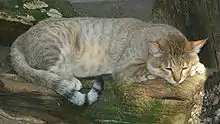
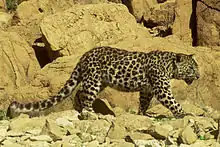
There are over 260 species of carnivorans, the majority of which eat meat as their primary dietary item. They have a characteristic skull shape and dentition.
- Suborder: Feliformia
- Family: Felidae (cats)
- Subfamily: Felinae
- Subfamily: Pantherinae
- Genus: Panthera
- Leopard, P. pardus VU[12]
- Arabian leopard, P. p. nimr CR[12]
- Leopard, P. pardus VU[12]
- Genus: Panthera
- Family: Viverridae
- Genus: Genetta
- Common genet, G. genetta LC[13]
- Genus: Genetta
- Family: Herpestidae (mongooses)
- Subfamily: Herpestinae
- Genus: Herpestes
- Indian grey mongoose, H. edwardsii LC[14]
- Genus: Ichneumia
- White-tailed mongoose, I. albacauda LC[15]
- Family: Hyaenidae (hyaenas)
- Genus: Hyaena
- Striped hyena, H. hyaena LC[16]
- Genus: Hyaena
- Family: Felidae (cats)
- Suborder: Caniformia
- Family: Canidae (dogs, foxes)
- Genus: Canis
- Golden jackal, C. aureus LC[17]
- Gray wolf, C. lupus [18]
- Arabian wolf, C. l. arabs
- Genus: Vulpes
- Blanford's fox, V. cana LC[19]
- Rüppell's fox, V. rueppellii LC[20]
- Red fox, V. vulpes LC[21]
- Genus: Canis
- Family: Mustelidae (mustelids)
- Genus: Mellivora
- Honey badger, M. capensis LC[22]
- Genus: Mellivora
- Family: Canidae (dogs, foxes)
Order: Artiodactyla (even-toed ungulates)
The even-toed ungulates are ungulates whose weight is borne about equally by the third and fourth toes, rather than mostly or entirely by the third as in perissodactyls. There are about 220 artiodactyl species, including many that are of great economic importance to humans.
- Family: Bovidae (cattle, antelope, sheep, goats)
- Subfamily: Antilopinae
- Genus: Gazella
- Arabian gazelle, G. arabica VU
- Arabian sand gazelle, G. marica VU[23]
- Saudi gazelle, G. saudiya EX[24]
- Genus: Gazella
- Subfamily: Caprinae
- Genus: Capra
- Nubian ibex, C. nubiana VU[25]
- Genus: Capra
- Subfamily: Hippotraginae
- Genus: Oryx
- Arabian oryx, O. leucoryxVU[26] reintroduced
- Genus: Oryx
- Subfamily: Antilopinae
- Family: Camelidae
Extirpated
The following species are locally extinct in the country:
See also
References
- Piraccini, R. (2016). "Myotis emarginatus". IUCN Red List of Threatened Species. 2016: e.T14129A22051191.
- Benda, P.; Srinivasulu, C.; Srinivasulu, B. (2019). "Rhyneptesicus nasutus". IUCN Red List of Threatened Species. 2019: e.T7935A22117147.
- Gazaryan, S.; Bücs, S. & Çoraman, E. (2020). "Miniopterus schreibersii". IUCN Red List of Threatened Species. 2020: e.T81633057A151216401.
- Piraccini, R. (2016). "Rhinolophus ferrumequinum". IUCN Red List of Threatened Species. 2016: e.T19517A21973253.
- Taylor, P. (2016). "Rhinolophus hipposideros". IUCN Red List of Threatened Species. 2016: e.T19518A21972794.
- Carpenter E. K.. 1997. Living Marine Resources of Kuwait, Eastern Saudi Arabia, Bahrain, Qatar, and the United Arab Emirates - Marine Mammals. pp.255-260. The Food and Agriculture Organization. Retrieved on April 14, 2017
- Baldwin R.. Gallagher M.. Waerebeek V. K..A Review of Cetaceans from Waters off the Arabian Peninsula (pdf). Retrieved on April 14, 2017
- "Megaptera novaeangliae (Arabian Sea subpopulation)". IUCN Red List of Threatened Species.
- Babbington J.. 2013. Indo-Pacific Bottlenose Dolphin – Offshore Farasan Islands. Birds of Saudi Arabia. Retrieved on April 14, 2017
- Avgan, B.; Henschel, P. & Ghoddousi, A. (2016). "Caracal caracal". IUCN Red List of Threatened Species. 2016: e.T3847A102424310.
- Sliwa, A.; Ghadirian, T.; Appel, A.; Banfield, L.; Sher Shah, M. & Wacher, T. (2016). "Felis margarita". IUCN Red List of Threatened Species. 2016: e.T8541A50651884.
- Stein, A.B.; Athreya, V.; Gerngross, P.; Balme, G.; Henschel, P.; Karanth, U.; Miquelle, D.; Rostro-Garcia, S.; Kamler, J. F.; Laguardia, A.; Khorozyan, I. & Ghoddousi, A. (2019). "Panthera pardus". IUCN Red List of Threatened Species. 2019: e.T15954A160698029.
- Gaubert, P.; Carvalho, F.; Camps, D. & Do Linh San, E. (2015). "Genetta genetta". IUCN Red List of Threatened Species. 2015: e.T41698A45218636.
- Mudappa, D. & Choudhury, A. (2016). "Herpestes edwardsii". IUCN Red List of Threatened Species. 2016: e.T41611A45206787.
- Do Linh San, E. (2015). "Ichneumia albicauda". IUCN Red List of Threatened Species. 2015: e.T41620A45208640.
- AbiSaid, M. & Dloniak, S.M.D. (2015). "Hyaena hyaena". IUCN Red List of Threatened Species. 2015: e.T10274A45195080.
- Hoffmann, M.; Arnold, J.; Duckworth, J. W.; Jhala, Y.; Kamler, J. F. & Krofel, M. (2018). "Canis aureus". IUCN Red List of Threatened Species. 2018: e.T118264161A46194820.
- Boitani, L.; Phillips, M. & Jhala, Y. (2018). "Canis lupus". IUCN Red List of Threatened Species. 2018: e.T3746A119623865.
- Hoffmann, M. & Sillero-Zubiri, C. (2015). "Vulpes cana". IUCN Red List of Threatened Species. 2015: e.T23050A48075169.
- Mallon, D.; Murdoch, J.D. & Wacher, T. (2015). "Vulpes rueppelli". IUCN Red List of Threatened Species. 2015: e.T23053A46197483.
- Hoffmann, M. & Sillero-Zubiri, C. (2016). "Vulpes vulpes". IUCN Red List of Threatened Species. 2016: e.T23062A46190249.
- Do Linh San, E.; Begg, C.; Begg, K. & Abramov, A. V. (2016). "Mellivora capensis". IUCN Red List of Threatened Species. 2016: e.T41629A45210107.
- IUCN SSC Antelope Specialist Group (2017). "Gazella marica". IUCN Red List of Threatened Species. 2017: e.T8977A50187738.
- IUCN SSC Antelope Specialist Group (2016). "Gazella saudiya". IUCN Red List of Threatened Species. 2016: e.T8980A50187890.
- Ross, S.; Elalqamy, H.; Al Said, T. & Saltz, D. (2020). "Capra nubiana". IUCN Red List of Threatened Species. 2020: e.T3796A22143385.
- IUCN SSC Antelope Specialist Group (2017). "Oryx leucoryx". IUCN Red List of Threatened Species. 2017: e.T15569A50191626.
- Durant, S.; Mitchell, N.; Ipavec, A. & Groom, R. (2015). "Acinonyx jubatus". IUCN Red List of Threatened Species. 2015: e.T219A50649567.
- Kaczensky, P.; Lkhagvasuren, B.; Pereladova, O.; Hemami, M. & Bouskila, A. (2020). "Equus hemionus". IUCN Red List of Threatened Species. 2020: e.T7951A166520460.
- Bauer, H.; Packer, C.; Funston, P. F.; Henschel, P. & Nowell, K. (2016). "Panthera leo". IUCN Red List of Threatened Species. 2016: e.T15951A115130419.
External links
- "Animal Diversity Web". University of Michigan Museum of Zoology. 1995–2006. Retrieved 22 May 2007.
